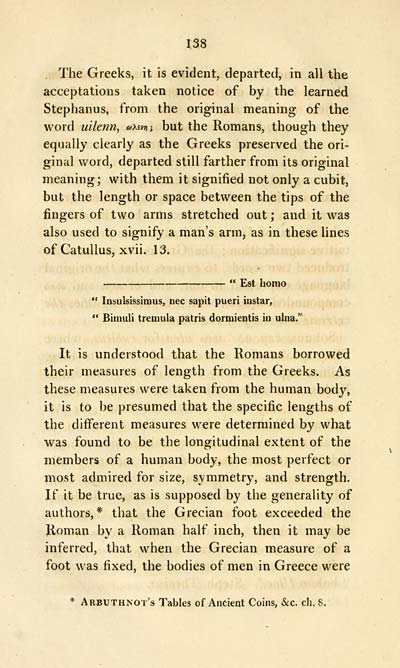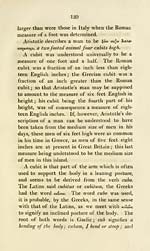Download files
Complete book:
Individual page:
Thumbnail gallery: Grid view | List view

138
The Greeks, it is evident, departed, in all the
acceptations taken notice of by the learned
Stephanus, from the original meaning of the
word uiletm, u>.m; but the Romans, though they
equally clearly as the Greeks preserved the ori-
ginal word, departed still farther from its original
meaning; with them it signified not only a cubit,
but the length or space between the tips of the
fingers of two arms stretched out ; and it was
also used to signify a man's arm, as in these Unes
of Catullus, xvii. 13.
Est homo
" Insukissimus, nee sapit pueri instar,
" Biniuli treniula patris dormientis in ulna."
It is understood that the Romans borrowed
their measures of length from the Greeks. As
these measures were taken from the human body,
it is to be presumed that the specific lengths of
the different measures were determined by what
was found to be the longitudinal extent of the
members of a human body, the most perfect or
most admired for size, symmetry, and strength.
If it be true, as is supposed by the generality of
authors,^ that the Grecian foot exceeded the
Roman by a Roman half inch, then it may be
inferred, that when the Grecian measure of a
foot was fixed, the bodies of men in Greece were
* Arbuthnot's Tables of Ancient Coins, &c. ch. 8.
The Greeks, it is evident, departed, in all the
acceptations taken notice of by the learned
Stephanus, from the original meaning of the
word uiletm, u>.m; but the Romans, though they
equally clearly as the Greeks preserved the ori-
ginal word, departed still farther from its original
meaning; with them it signified not only a cubit,
but the length or space between the tips of the
fingers of two arms stretched out ; and it was
also used to signify a man's arm, as in these Unes
of Catullus, xvii. 13.
Est homo
" Insukissimus, nee sapit pueri instar,
" Biniuli treniula patris dormientis in ulna."
It is understood that the Romans borrowed
their measures of length from the Greeks. As
these measures were taken from the human body,
it is to be presumed that the specific lengths of
the different measures were determined by what
was found to be the longitudinal extent of the
members of a human body, the most perfect or
most admired for size, symmetry, and strength.
If it be true, as is supposed by the generality of
authors,^ that the Grecian foot exceeded the
Roman by a Roman half inch, then it may be
inferred, that when the Grecian measure of a
foot was fixed, the bodies of men in Greece were
* Arbuthnot's Tables of Ancient Coins, &c. ch. 8.
Set display mode to: Large image | Transcription
Images and transcriptions on this page, including medium image downloads, may be used under the Creative Commons Attribution 4.0 International Licence unless otherwise stated. ![]()
| Early Gaelic Book Collections > Ossian Collection > Thoughts on the origin and descent of the Gael > (150) |
|---|
| Permanent URL | https://digital.nls.uk/82236244 |
|---|
| Description | Selected books from the Ossian Collection of 327 volumes, originally assembled by J. Norman Methven of Perth. Different editions and translations of James MacPherson's epic poem 'Ossian', some with a map of the 'Kingdom of Connor'. Also secondary material relating to Ossianic poetry and the Ossian controversy. |
|---|
| Description | Selected items from five 'Special and Named Printed Collections'. Includes books in Gaelic and other Celtic languages, works about the Gaels, their languages, literature, culture and history. |
|---|

